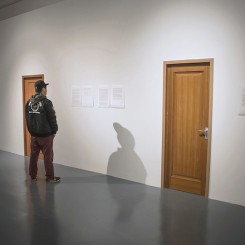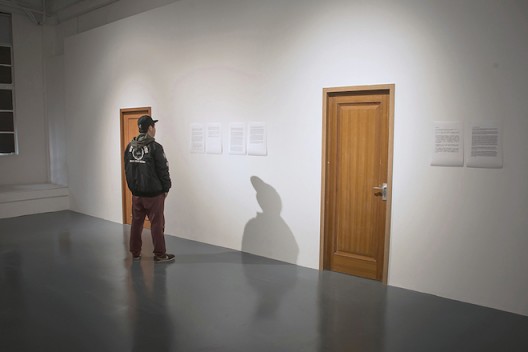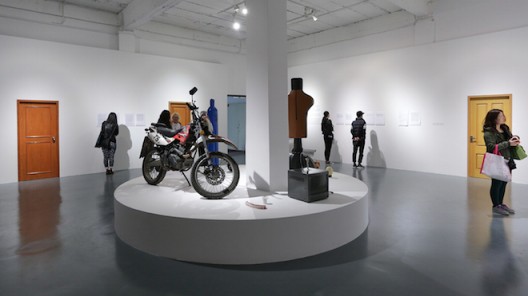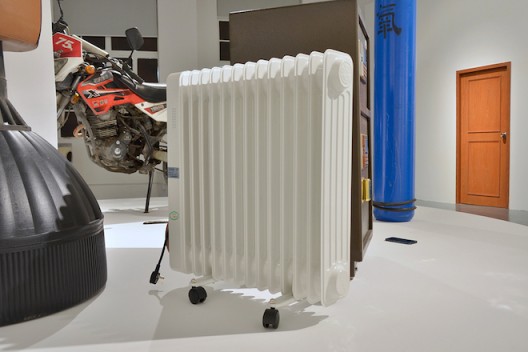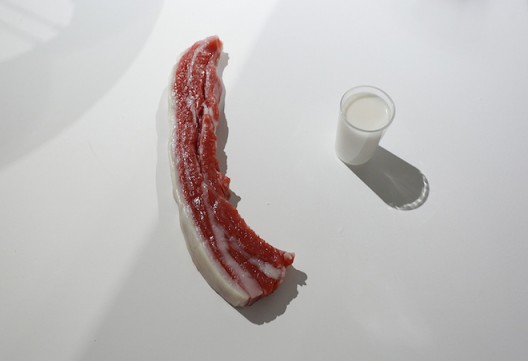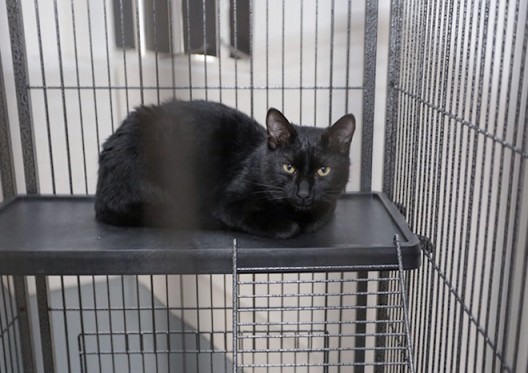Lu Pingyuan Solo Exhibition: “Unexpected Discovery”
MadeIn Gallery (4/F, Building 7, 50 Moganshan Lu, Shanghai), Mar 21–May 17, 2015
I’ve known about Lu Pingyuan’s stories for a long time, and even read a few of them myself. They read like contemporary version of Liaozhai1—somewhat nonsensical and playful, with specious connections to art. I was curious to see how these stories would be transformed into artworks. Can Lu turn these tales of the phantasmagoria into works of contemporary art and make them venture beyond the scope of literature by setting them in an art context? Or has the artist simply decided to be a writer who works in and with the world of contemporary art?
I found my answer when I saw the “Unexpected Discovery” exhibition at MadeIn Gallery, which was an “unexpected discovery” of my own.
Eight stories were presented in the exhibition, each of them simply printed on sheets of A3 paper and stuck on the gallery’s white walls. Within contemporary art, it is by no means rare to display texts like this, but text usually just functions as an additional explanatory, narrative or archival element that serve to enrich an art piece. In Lu Pingyuan’s case, however, the text is the art piece. It does out even have any visual manipulation. A display setting like this immediately gives off a sense of experimentation. What’s more, with the strong narrative quality of these texts, how do they then cast off the attributes of literature to become contemporary art (regardless of whether they lead to material components or not)? Taking all of this into account, the first objective of Lu Pingyuan’s project would be to resolve this contradiction and to render logical his stories as an art project.
Lu Pingyuan rises to this challenge in the way he deals with two stories in the series—“Schrödinger’s Mom” and “Unexpected Payback”. These pieces also happen to highlight a few important facets of his art.
“Schrödinger’s Mom” relates one of the author’s life experiences. While visiting his hometown one year during Spring Festival, through the haze of an afternoon nap, he watched a female house cat transform into a seductive woman. One thing led to another, they got intimate…but afterwards he could never be sure if he had imagined the encounter. Several months later, he received a message from his hometown informing him that the cat had had a litter of kittens, and two had survived. The author then became absolutely convinced that his experience was, in fact, reality. He was the father of two kittens. He named one of the kittens “Schrödinger” (“Schrödinger’s Cat” is a thought experiment about the Uncertainty Principle in quantum theory devised by the Austrian physicist Erwin Schrödinger in 1935). This black cat has found a temporary home in the exhibition space, sleeping in its cage during the day, and wandering the empty gallery at night. The story is a modern take on the classic trope of romance between fox spirits and scholars in Chinese tales of the supernatural.
Symbols of traditional Chinese culture like Feng Shui and Bagua, Yin-Yang and the Five Phases, traditional Chinese medicine and the Meridian system appeared frequently in contemporary Chinese art. Most works of this type revolve around visual symbols and ritual, but Lu Pingyuan engages in a different form of experimentation here. His use of the fantastical achieves a rationale in line with conceptual art while remaining rich in logic. “Schrödinger’s Mom” bears the outward appearance of a vulpine myth, but hides a cache of contemporary artistic metaphors within: if the work was borne of a fantastical intercourse between the artist and his ego through which the artist derived pleasure, pleasure itself is the artwork (the story). Otherwise, the work is borne of the object upon which the artist has pinned his self-consciousness; the object becomes the art work (the black cat).
Another work, “Unexpected Payback”, relates the following story: one evening, the author chanced upon a hungry beggar sleeping on the streets. The old man begged the author for food, and the author obliged him. When the beggar learned that the author was an artist, as a reward, he taught the author secret magic for creating art. The beggar’s exact words were, “From now on, you don’t have to do anything. You’ll stare at something—just stare at if for twenty-four hours—and that thing will become your work of art.” The author (Lu Pingyuan) then applied the old beggar’s secret magic, “staring” at series of “works” which he exhibits on a circular platform in the center of the gallery space. These objects include a motorcycle, a monitor, an iPhone5, a heater and some plastic models of food. Even the obtrusive white column jutting out of the circular exhibition platform became a piece of art because it was subject to the artist’s gaze for 24 hours while setting up the exhibition.
Lu Pingyuan has worked with MadeIn Company for many years, so it might be imagined the trajectory of his thoughts and matters of his concern might well overlap in some areas with those of MadeIn Company or his “boss” Xu Zhen. However, Lu Pingyuan has clearly adopted a much lighter artistic approach; he is able to clearly express his problems without the drama of a large-scale campaign, employing neither pomp nor circumstance. A one-stop spectacle ridiculing the production, replication, packaging, exhibition and circulation of art is certainly satisfying in the extreme, but “Unexpected Payback” gives us an extremely simple yet reasonable means to distinguish art from a pile of random objects. In this way, the “means of production” of artworks and of artistic conceptualization is thereby totally liberated—and what a relief it is. All of the “works” upon the circular platform are effectively a “play within a play”, because they may simultaneously be identified as works by the artist Lu Pingyuan and works of the story’s protagonist who has been bequeathed a magical secret from a mystic-beggar. Personally, I am more inclined to attribute the pieces to the latter Lu Pingyuan, but of course the artist would never admit they are not one and the same.
The two stories detailed above were the only ones configured with physical elements; the remaining six tales were presented only as texts. This decision was made after careful consideration, as the two stories/works are already sufficient in conveying the artist’s processes of thought. They further set the context for the remaining six stories to become more than mere ghost stories, while simultaneously bringing the witty logic of the entire exhibition to full fruition.
Lu Pingyuan tells me he has set aside an area in his home just for composing these bizarre tales. This area is a tiny nook nestled between two rooms—a space just big enough for a single person to write in. He says this is where he feels most secure, where he won’t feel the creeping horrors of the stories slinking into him. Because, after all, he says all of the stories are true.
1 Liazhai Zhiyi, or Strange Stories from a Chinese Studio, was a collection of ghost and supernatural stories compiled and written by Pu Songling, probably in the early 18th century.
